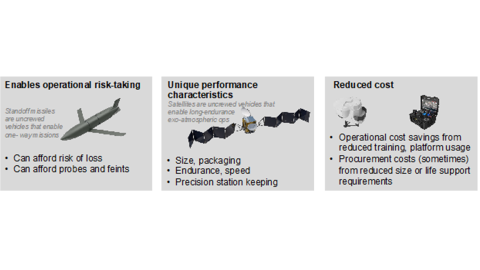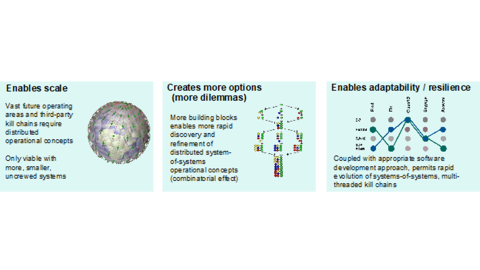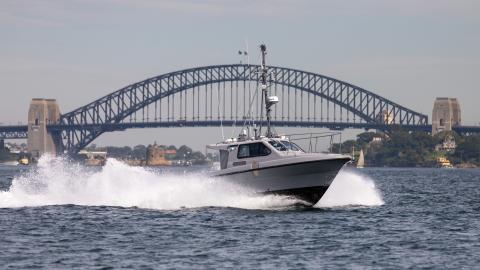View PDF with Figures and Maps
1. Introduction
The Australian Defence Force (ADF) is aggressively pursuing a diverse array of uncrewed air, surface, and undersea systems to address capability gaps in today’s force and exploit emerging opportunities in new technology. Thus far, these efforts have yielded a few programs that have transitioned into operational use, consisting predominantly of uncrewed air vehicles (UAV) that support intelligence, surveillance, and reconnaissance (ISR) operations.
ADF concepts tend to constrain uncrewed system use cases by treating them as extensions of crewed platforms or units, such as the Royal Australia Air Force (RAAF) Ghost Bat program.1 These manned-unmanned teaming (MUM-T) concepts generally exploit the systems-level characteristics of uncrewed vehicles to provide crewed units with greater reach or persistence, as figure 1 summarizes. Because they do not carry human operators, strategists can consider even relatively expensive uncrewed vehicles attritable, and forces may lose these vehicles to combat or other exigencies with little regret.2 Uncrewed systems can operate for extended periods in severe environments or circumstances, such as space. And without human operators, uncrewed vehicles can be less expensive than their manned counterparts due to fewer requirements for life support, protection, live training, or multi-mission capability.
Figure 1: System-level Value Proposition for Pursuing Uncrewed Solutions

Source: Authors.
Using uncrewed systems only to extend the reach and persistence of crewed units made sense during the post–Cold War era. Militaries pursued efficiencies by fielding a smaller crewed force to sustain peacetime security commitments while relying on a growing portfolio of uncrewed space and airborne sensors to enable networked precision-strike warfare in conflict.3 The same need for efficiency exists today—even as defense budgets rise across most countries—because personnel costs are generally the fastest-growing component of defense spending, followed by maintenance for crewed platforms.
Although efficient, employing uncrewed systems as extensions of crewed units tends to perpetuate the limitations of crewed units while failing to take advantage of the ability of uncrewed technologies to improve a force’s flexibility and resilience.
- To protect their operators, crewed units need self-defense and survivability features that raise their cost.
- To justify their expense, crewed units are generally multi-mission capable, further increasing their cost and complexity.
- Crewed units are expensive to buy and maintain, while costs for operator compensation continue to rise faster than defense budgets, leading the ADF—like other allied militaries—to reduce its fleets of crewed ships and aircraft.4
- Crewed units often require protection and logistics support for operations beyond a few days or in a contested environment, necessitating standardized force packages like army brigades or navy surface action groups.
- Because they depend on human operators, crewed units tend to rely on relatively well-defined tactics that allow for commonality in training.
- Despite being multi-mission capable, crewed units generally cannot conduct more than one or two missions at a time due to limits on operator workload.
The Australian military’s most capable competitor, China’s People’s Liberation Army (PLA), has exploited the dependability of allied force compositions and tactics in its concept of system destruction warfare, or systems warfare. Under this approach, the PLA assesses the systems of systems (SoS) that Australian forces are likely to use in combat and the potential vulnerabilities in those systems. The PLA then develops and fields capabilities that can attack perceived weaknesses and undermine the ability of the Australian and allied militaries to intervene on behalf of partners like Taiwan.5 For example, the PLA fields a variety of electronic warfare systems that target key allied networks such as Link-16 and sensors such as those on airborne early warning (AEW) aircraft.6 In implementing systems warfare, the PRC has exploited commercial and proliferated military technologies to undermine traditional allied advantages in air defense, precision strike, and long-range power projection.7
Against a peer adversary like China, the Australian military will need to be less predictable and more adaptable. Instead of deriving advantage strictly through superior weapon, sensor, or platform technology, the ADF will need to gain an edge through force employment and associated command, control, and communications (C3) capabilities. However, budget constraints will prevent the Australian military from creating more options for commanders by simply growing the existing, mostly crewed, force. To surmount this obstacle, the ADF will need to expand the proportion of the force comprising uncrewed systems while investing in the ability to identify and integrate new effects chains using artificial intelligence–enabled C3 software.8
Rather than acting as extensions of crewed units, uncrewed systems will need to perform as independent elements of effects chains—or the combination of sensor, decision-maker, and weapon that deliver an effect on the battlefield. Whereas Cold War–era platform-based warfare relied on crewed aircraft, ships, or ground formations that contain most or all pieces of their own effects chains, an SoS approach assumes that different elements of the force will likely provide each link of an effects chain, from finding targets through engagement and assessment.9
Figure 2: Systems-of-systems Value Proposition for Pursuing Uncrewed Solutions

Source: Authors.
As figure 2 summarizes, adopting an SoS approach to force employment will allow the Australian military to fully exploit the characteristics of uncrewed systems. Because they are less expensive than crewed units, uncrewed systems can enable distributing the missions of crewed platforms into individual uncrewed units so they can be performed in parallel. The advent of a robust commercial robotics technology ecosystem further expands this opportunity by lowering costs and avoiding time-consuming research and development (R&D). With their scale and expendability, uncrewed systems can grow the variety of effects chains available to commanders and the dilemmas they impose on adversaries¾provided that militaries treat them as independent players in an SoS. And because uncrewed systems can be more specialized and modular than crewed units that require multi-mission capability, forces can more easily plug them into effects chains to adapt an SoS to new missions or environments or enable a force to continue a mission despite losses.
However, the need for uncrewed systems to contribute to adaptable effects chains as part of multiple SoS creates challenges for system development and integration. When developers design uncrewed systems as extensions of crewed units, such as in ISR operations, they can firmly define and pursue these systems’ requirements through conventional linear research and development. If an uncrewed system could participate in different SoS, its requirements could change depending on the other participants in the SoS. Crewed units overcome this challenge by establishing relatively ambitious requirements that capture the range of reasonable situations the unit could face. This approach results in capable and survivable units that are also too expensive to field at scale. Uncrewed systems will need a different approach for requirements and acquisition that assumes an SoS context.
The assumption of an SoS context is common in commercial technology development. Companies often develop a product to initially support a threshold “use case” or a combination of SoS configuration and application, such as a smartphone connecting through a cellular radio access network and the internet to access content on a website. Companies can develop other use cases over time as new SoS elements emerge or as they can realize new combinations of systems. The greater technology opportunity in commercial products therefore resides in integrating new SoS elements rather than in incrementally improving individual systems’ characteristics. For example, the streaming revolution that has dominated television and music delivery during the last decade resulted from the ability to integrate existing content providers, high-speed broadband internet backbones, 4GLTE or 5G networks, and mobile devices.
Similarly, The Australian Department of Defence (ADoD) will need to reframe its technological challenge as less about developing the next generation of weapons and more about flexibly integrating existing and emerging capabilities to better address the threats and opportunities posed by peer competitors like the PLA. With their ability to expand a military’s scale and options, uncrewed systems are likely to be central to future SoS. The following chapters will therefore explore how the ADF could most effectively integrate uncrewed systems. Chapter 2 will address the idea of autonomy and how limits on autonomy should shape ADF SoS development. Chapter 3 describes how the ADF could identify and field uncrewed systems through prototyping and experimentation instead of extended R&D programs, as is the norm for crewed platforms. The report concludes by summarizing the study’s recommendations in chapter 4.




















